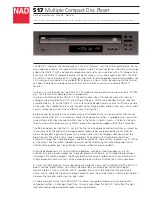
12
6. Lower head to desired cut depth for next pass.
Flip the material over and re-feed it through
machine.
7. Repeat procedure as necessary. If a jam
occurs, turn planer OFF and raise head to
withdraw the workpiece.
9.3
Start/stop
Make sure switch is in OFF
position before plugging in the planer.
If a power outage occurs, the planer will restart
when power is restored. If an outage occurs,
immediately turn off machine at the switch.
Pull up paddle switch to start planer, push it down to
stop.
To prevent unauthorized operation, turn off planer,
pull yellow safety key out of switch and store it in a
secure location. See Figure 9-1. To restart the
planer, insert key and push until it “snaps” in.
Note: The safety key can be removed while the
planer is operating, but once shut off, the planer will
not restart without the safety key reinserted.
Figure 9-1: on/off switch and safety key
9.4
Circuit breaker reset
The planer is equipped with a motor protective
device (circuit breaker). The breaker will shut the
planer off automatically when excessive current is
consumed. If this occurs:
1. Press the OFF switch.
2. Raise head and withdraw the workpiece.
3. Allow planer to cool for a few minutes, then
push reset button (see Figure 4-1) and restart
the planer.
Be sure to turn planer OFF before resetting the
circuit breaker to avoid unintentional starting.
If the circuit breaker trips frequently, consult
sect.
11.0, Troubleshooting the JWP-13BT
.
9.5
Feed rate
Move feed rate selector (see Figure 4-1) to desired
rate of 18 or 26 feet per minute, while planer is
operating.
Only move feed rate selector
while planer is running. Moving selector with
planer stopped will cause stress to roller gear
engagement at start-up, resulting in possible
damage to gear system.
9.6
Planing warped wood
Do not attempt to plane a board
which is warped along its length. A warped
board can jam itself against the cutterhead
knives resulting in kickback and/or damage to
the planer.
Note that if a significantly cupped board is fed into
the planer, the feed rollers will press it flat for the
pass, but the wood will spring back into cupped form
when it has cleared the rollers. For best results, one
side of the material should be run through a jointer
to achieve a flat surface prior to planing. However, if
a board is only moderately cupped you may attempt
to plane it.
If the board is narrow enough, consider using a table
saw or band saw to rip the top of the warp before
planing the board. If this is not practical, feed the
board into the planer concave side down and plane
the top of the board until it presents a flat surface.
Turn the board over and plane the bottom edges
until they are flush with the middle. After planing the
board, use a table saw or band saw to square the
board’s edges with the top and bottom surfaces.
Cupping can often be diminished by ripping the
board into narrower pieces on a table saw or band
saw. See Figure 9-2.
Figure 9-2: cupping reduction
9.7
Grain direction
Always feed the board so the knives are cutting in
the same direction as the wood grain, as shown in
Figure 9-3. If you cut against the grain, the wood can
“chip out” leaving an undesirable finish. See Figure
9-4.













































